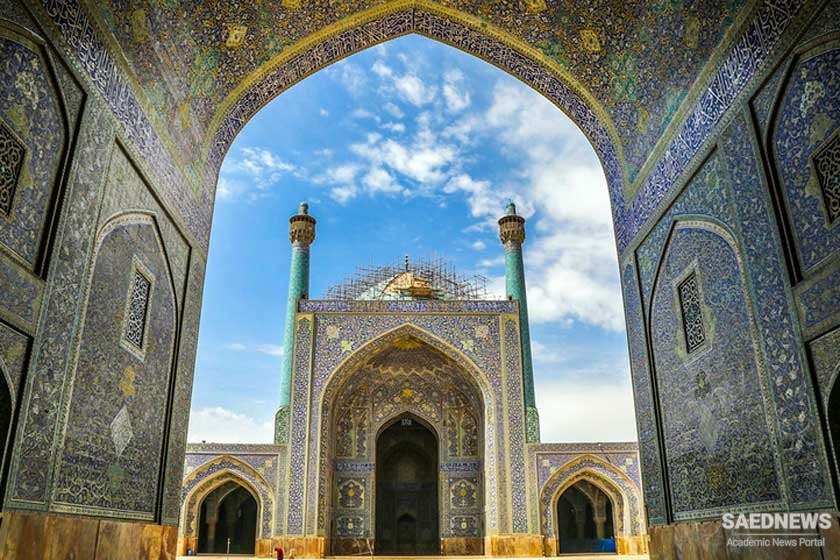It is regarded as one of the masterpieces of Persian architecture in the Islamic era. The Royal Mosque is registered, along with the Naghsh-e Jahan Square, as a UNESCO World Heritage Site. Its construction began in 1611, and its splendour is mainly due to the beauty of its seven-colour mosaic tiles and calligraphic inscriptions.
The mosque is depicted on the reverse of the Iranian 20,000 rials banknote.
In 1598, when Shah Abbas decided to move the capital of his Persian empire from the northwestern city of Qazvin to the central city of Isfahan, he initiated what would become one of the greatest programmes in Persian history; the complete remaking of this ancient city. By choosing the central city of Isfahan, fertilized by the Zāyandeh River ("The life-giving river"), lying as an oasis of intense cultivation in the midst of a vast area of arid landscape, he both distanced his capital from any future assaults by Iran's neighboring arch rival, the Ottomans, and at the same time gained more control over the Persian Gulf, which had recently become an important trading route for the Dutch and British East India Companies.
The chief architect of this task of urban planning was Shaykh Bahai (Baha' ad-Din al-`Amili), who focused the programme on two key features of Shah Abbas's master plan: the Chahar Bagh avenue, flanked at either side by all the prominent institutions of the city, such as the residences of all foreign dignitaries, and the Naqsh-e Jahan Square ("Exemplar of the World"). Prior to the Shah's ascent to power, Persia had a decentralized power structure, in which different institutions battled for power, including both the military (the Qizilbash) and governors of the different provinces making up the empire. Shah Abbas wanted to undermine this political structure, and the recreation of Isfahan, as a Grand capital of Persia, was an important step in centralizing the power. The ingenuity of the square, or Maidān, was that, by building it, Shah Abbas would gather the three main components of power in Persia in his own backyard; the power of the clergy, represented by the Masjed-e Shah, the power of the merchants, represented by the Imperial Bazaar, and of course, the power of the Shah himself, residing in the Ali Qapu Palace.
The crown jewel in this project was the Masjed i Shah, which would replace the much older Jameh Mosque in conducting the Friday prayers. To achieve this, the Shah Mosque was constructed not only with vision of grandeur, having the largest dome in the city, but Shaykh Bahai also planned the construction of two religious schools and a winter mosque clamped at either side of it. Because of the Shah's desire to have the building completed during his lifetime, shortcuts were taken in the construction; for example, the Shah ignored warnings by one of the architects Abu'l Qāsim regarding the danger of subsidence in the foundations of the mosque, and he pressed ahead with the construction. The architect proved to have been justified, as in 1662 the building had to undergo major repairs. Also, the Persians decorated the mosque with the Seven-colored wall tiles that was both cheaper and quicker, and that eventually sped up the construction. This job was done by some of the best craftsmen in the country, and the whole work was supervised by Master calligrapher, Reza Abbasi. In the end, the final touches on the mosque were made in late 1629, A few months after the death of the Shah.
Also, many historians have wondered about the peculiar orientation of The Royal square (The Maidān). Unlike most buildings of importance, this square did not lie in alignment with Mecca, so that when entering the entrance-portal of the mosque, one makes, almost without realising it, the half-right turn, which enables the main court within to face Mecca. Donald Wilber gives the most plausible explanation to this; the vision of Shaykh Bahai was for the mosque to be visible wherever in the maydān a person was situated. Had the axis of the maydān coincided with the axis of Mecca, the dome of the mosque would have been concealed from view by the towering entrance portal leading to it. By creating an angle between them, the two parts of the building, the entrance portal and the dome, are in perfect view for everyone within the square to admire.


 Imam Mosque of Isfahan
Imam Mosque of Isfahan














































